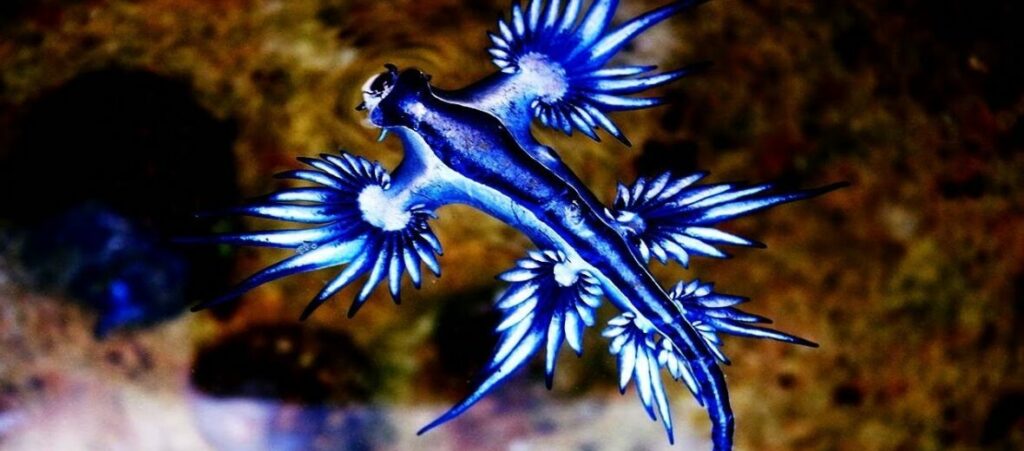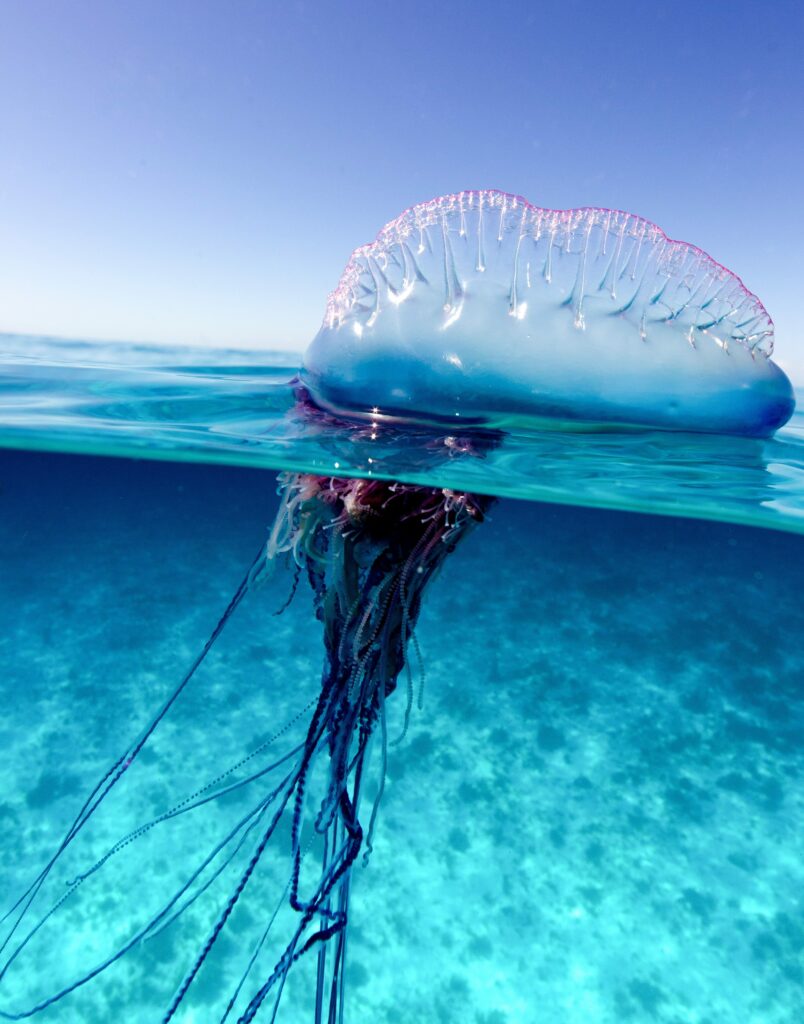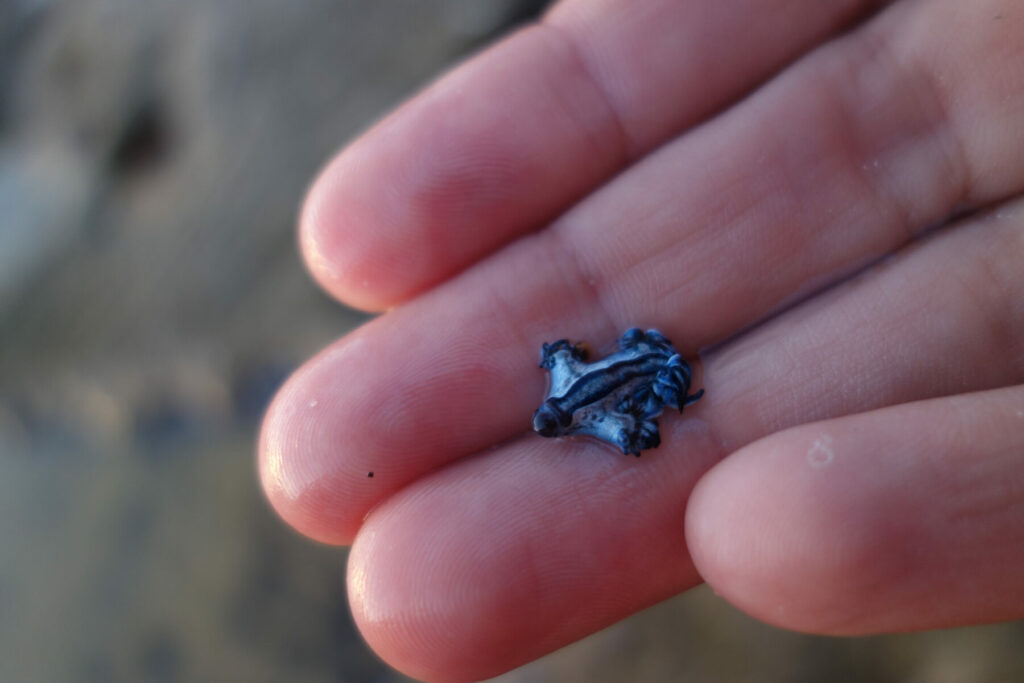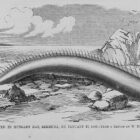Why Is the Blue Sea Dragon Dangerous?

The blue sea dragon (Glaucus atlanticus), also known as blue angel, blue glaucus, dragon slug and blue dragon, is a fascinating yet potentially dangerous creature inhabiting the world’s oceans. Unlike its mythical counterpart, this creature is not a dragon in the traditional sense but rather a small, delicate species of nudibranch, or sea slug.
Found primarily in warm oceanic waters, these creatures possess a captivating appearance, with their vibrant blue hues and intricate patterns, but beneath their beauty lies a potent danger.
Physical Characteristics
Measuring only a few centimeters in length, the blue sea dragon might seem inconspicuous at first glance. However, its physical characteristics are anything but ordinary, distinguishing it as a marvel of evolution in the vast expanse of the ocean.
Unlike their benthic relatives, which inhabit the ocean floor, pelagic nudibranchs like the blue sea dragon are free-swimming organisms, drifting with the currents and tides across vast stretches of oceanic waters.
The dorsal side of the creature displays a mesmerizing shade of blue, ranging from azure to cobalt, often accentuated by contrasting white or silver markings. This striking coloration serves multiple purposes, including camouflage and aposematism, warning potential predators of the sea dragon’s venomous nature.
In addition to its captivating coloration, the blue sea dragon possesses a streamlined and graceful body structure, reminiscent of a miniature dragon gliding effortlessly through the water. Its body is adorned with delicate cerata, specialized appendages that serve multiple functions, including respiration, digestion, and defense. These cerata are arranged in rows along the sea dragon’s dorsal surface, forming intricate patterns that contribute to its overall aesthetic appeal.
Behavior and Feeding Habits
Intriguingly, the blue sea dragon is not a passive filter-feeder like many other nudibranchs. Instead, it is an active predator, specializing in hunting one of the ocean’s most notorious creatures: the Portuguese man o’ war. This gelatinous colonial organism floats near the ocean’s surface, its venom-filled tentacles trailing beneath, waiting to ensnare unsuspecting prey. While most marine organisms steer clear of the man o’ war’s stinging embrace, the blue sea dragon has evolved a remarkable adaptation to exploit this dangerous prey.

Equipped with a keen sense of smell and sensitive chemoreceptors, the sea dragon detects the chemical signature of its quarry from a distance. Once it locates a man o’ war, the sea dragon employs its slender, ribbon-like cerata to ensnare and immobilize the tentacles. These appendages are not just for show—they serve a vital purpose in the sea dragon’s hunting strategy. Each cerata is lined with thousands of tiny structures called cnidosacs, which house the nematocysts—the specialized stinging cells harvested from the man o’ war.
Eating Nematocysts
Once the sea dragon captures its prey, it begins a delicate process of consumption. Using its radula—a rasping tongue-like organ found in many mollusks—the sea dragon scrapes away at the man o’ war’s tissues, extracting vital nutrients while avoiding the venomous nematocysts.
Remarkably, the sea dragon is immune to the sting of its prey, thanks to specialized cells within its own tissues that neutralize the venom.
Venomous Defense Mechanisms
The primary source of the blue sea dragon’s venom lies in the nematocysts it collects from its prey, primarily the Portuguese man o’ war. These nematocysts are specialized stinging cells found within the tentacles of the man o’ war, designed to incapacitate and capture prey. However, rather than discarding these potent weapons after consuming its prey, the sea dragon repurposes them for its own defense.
Upon ingesting the nematocysts, the blue sea dragon transports them to specialized structures known as cnidosacs, located within its cerata. These cerata, which resemble finger-like projections along the sea dragon’s body, serve as both a means of propulsion and storage for the venomous nematocysts. When threatened, the sea dragon can discharge these nematocysts from its cerata, releasing a potent dose of venom into the surrounding water.

Painful Sting
The venom of the blue sea dragon, while potent, is not lethal to humans in most cases, but it can cause significant pain and discomfort. The venom is composed of a cocktail of bioactive compounds, including peptides and proteins, which serve various purposes in defense and predation. While the exact composition of the venom may vary slightly among individual blue sea dragons and populations, its general effects on larger animals can be described.
Upon contact with the skin of a larger animal, the venom of the blue sea dragon can cause intense pain, often described as a burning or stinging sensation. This pain is a result of the neurotoxic properties of some components of the venom, which interfere with the normal functioning of nerve cells. As a result, the affected individual may experience localized numbness, tingling, or paralysis in the area of the sting.
In addition to its neurotoxic effects, the venom of the blue sea dragon also contains cytolytic compounds that can cause damage to cell membranes and surrounding tissues. This can lead to swelling, inflammation, and the formation of blisters or welts at the site of the sting. In severe cases, the venom may induce systemic effects such as nausea, vomiting, and dizziness, as the toxins spread throughout the body.
While rare, allergic reactions to the venom of the blue sea dragon have also been reported in some individuals. These reactions can range from mild itching and hives to more severe symptoms such as difficulty breathing, chest tightness, and anaphylaxis. As with any venomous organism, individuals who are allergic to bee stings or other marine creatures may be at a higher risk of experiencing an allergic reaction to the blue sea dragon’s venom.
Impact on Marine Ecosystems
The blue sea dragon’s presence in marine ecosystems can have multifaceted impacts, both beneficial and detrimental. Understanding its role within these intricate systems is essential for comprehending the broader ecological implications of its existence.
As a predator of the Portuguese man o’ war, the blue sea dragon plays a critical role in regulating the population of this potentially harmful organism. Man o’ wars are notorious for their powerful sting, which can incapacitate prey and pose risks to humans. By preying on these organisms, the sea dragon helps control their numbers, thereby reducing the likelihood of human encounters and minimizing their impact on other marine life.
Like all predators, the blue sea dragon is part of a delicate balance within marine food webs. Its feeding habits influence the distribution and abundance of its prey, which in turn can affect the populations of other organisms further down the food chain. Disruptions to this balance, whether through overexploitation of sea dragon populations or declines in their prey species, can have ripple effects throughout marine ecosystems, leading to cascading impacts on biodiversity and ecosystem function.










